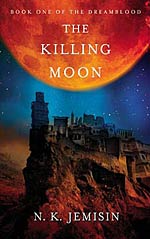
![]() SueCCCP
SueCCCP
1/14/2014
![]()
I have seen Ms Jemisin's titles recommended in several places, and this particular title has received a number of enthusiastic reviews (see below) and was nominated for several awards. I know that this is not her first series, but I was intrigued by the setting, which is heavily influenced by the culture of Ancient Egypt but with some intriguing fantasy elements.
At first, I was not quite sure what to think of the book because we are introduced to several of our lead characters in quick succession. I have to admit that I almost gave up after about thirty pages because I was starting to feel somewhat lost and overwhelmed by this sudden immersion into at least two distinctively alien cultures. However, I am glad that I persevered because I quickly became caught up in exploring the rich landscape of cultures, religions and magic. I wish that the publisher had included a map so that I could have made a little more sense of some of the geography, but picturing Gujaareh as Alexandria in Egypt seemed to work fairly well for me.
The Egyptian influences are clear, especially in the dependence upon the annual river Flood to support agriculture and life within a desert environment. There were also nods to Egyptian dress, etiquette and architecture. The society also shared a similar caste system and range of methods of writing their language, from detailed pictograms to less formal cursive scripts. However, there were enough differences to make the world unique and interesting. We hear mention of plants and animals that seem to have no cousins here on Earth, and the dream-based religious system is like nothing I have read before.
The religion that is so fundamental to this series is an interesting amalgam of the most ancient forms of moon worship with the theory of the four humors that was prevalent from the time of the Ancient Greeks right up until the rise of modern medicine. The priests attempts to cure people by balancing these humors is very similar to treatments, such as bleeding and purging, that used to be so common. I was also intrigued by the concept of death being a transition to a spiritual plane that could be made to resemble paradise by an experienced practitioner so that the dying soul could be happy eternally. This seemed like a very worthwhile goal for the Gatherers and was a good of the gray aspects of so much of this title: this religion has so many good things to be said about it, and yet it is open to abuse and perversion.
This refusal to paint anything or anyone as truly black or white was one of the aspects that I truly appreciated about this book because it made it seem much more realistic and also more difficult to predict what would happen next. This is also true of the characterizations: the people that we follow may or may not be heroes, and they do not always do good or noble things, but they are compelling because they seem so real. This does have the disadvantage that it is rather difficult to fall in love with them, but it makes for a very satisfying, character-driven storyline. By the end of the book you do care about the various leading characters, but there is no real feel of them being massively special or heroic, just normal humans placed in unusual situations.
I would recommend this title to anyone who wants to read about a truly original world and immerse themselves in some alien cultures. My only criticism is that it was a little slow to catch me at the beginning, so it may take a little longer than usual to get into it. However, keep going: it will be worth it and I am interested to know how the rest of the series plays out.
http://coffeecookiesandchilipeppers.blogspot.com